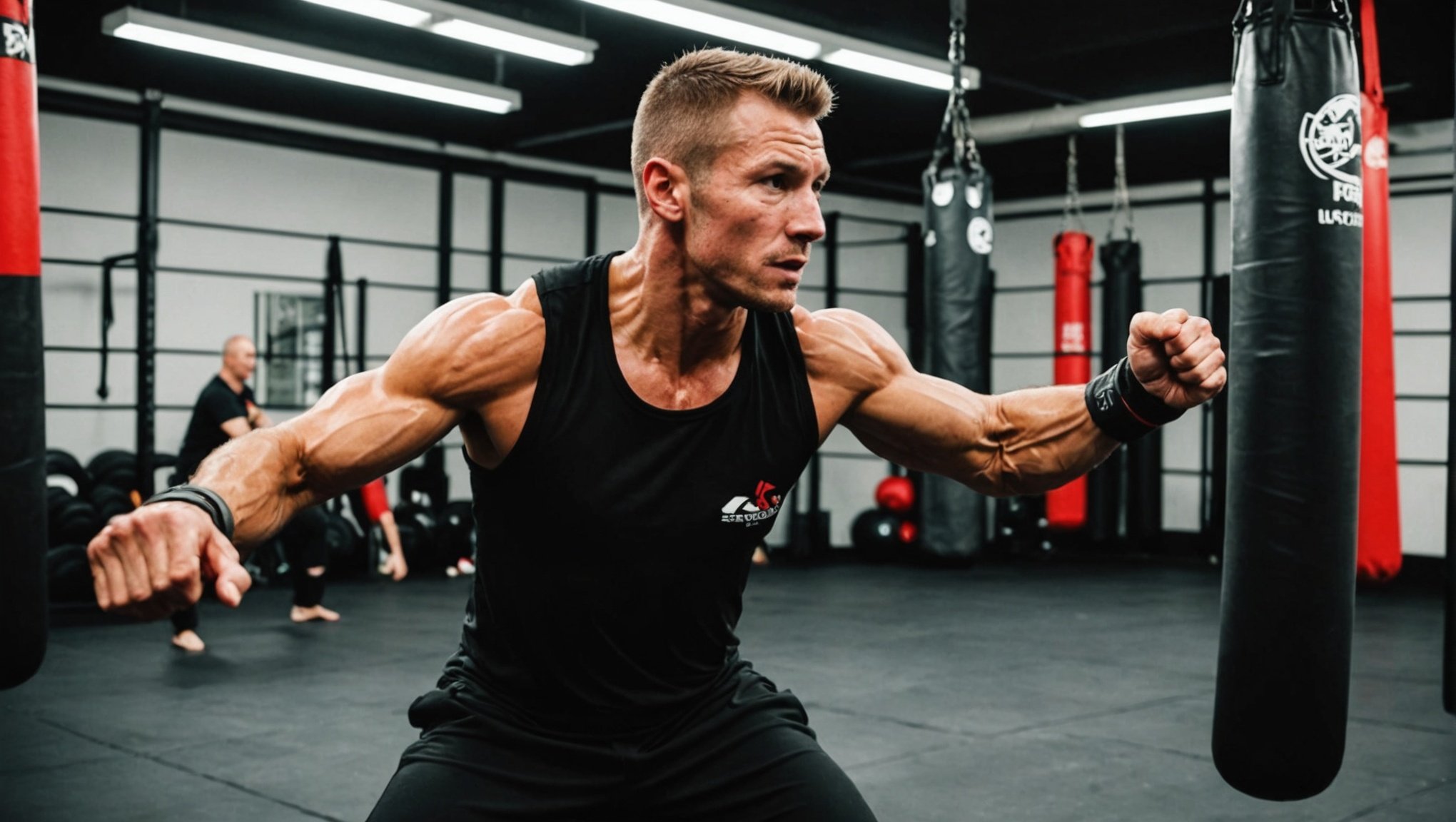Unlocking Striking Power: A Comprehensive Guide for UK Kickboxers on Using Resistance Bands to Resistance Bands in Kickboxing
For UK kickboxers looking to enhance their performance, incorporating resistance bands into their training regimen can be a game-changer. These versatile tools are not just limited to boxing; they can significantly improve strength, speed, and overall fitness, making them an essential component of any martial arts training.
Resistance bands, like those offered by MA Martial Arts Style, are designed to increase the intensity of each movement, thereby building strength, speed, and explosive power. Here’s how you can leverage these bands to take your kickboxing to the next level.
Have you seen this : Optimizing Nutrition for Muscle Recovery: A Guide for UK Combat Sports Athletes
Understanding the Benefits of Resistance Bands
Enhanced Strength and Power
Resistance bands are particularly effective in building strength and power, which are crucial for kickboxers. By adding resistance to your movements, you engage your muscles more intensely, leading to increased muscle mass and strength over time.
- Leg Strength: When training your kicks, resistance bands help enhance your leg strength. For example, using ankle cuffs with resistance bands while practicing kicks increases the resistance, making each kick more effective in building muscle and power[2].
- Upper Body Strength: Similarly, wrist straps and resistance bands can be used to enhance punching power. Drilling jabs and punch combinations with resistance bands builds power and explosiveness in your punches[2].
Improved Speed and Agility
Speed and agility are vital components of kickboxing. Resistance bands help improve these aspects by increasing the intensity of your movements.
Have you seen this : Mastering Timing and Precision: The Ultimate Guide for UK Boxers on Using Speed Bags
- Footwork: Training with resistance bands improves your footwork by making each step and movement more challenging. This translates to faster and more agile movements during actual fights[2].
- Punching Speed: The resistance provided by the bands also increases the speed of your punches. As you get accustomed to punching against resistance, your punching speed and accuracy improve significantly.
Versatility in Training
One of the most appealing aspects of resistance bands is their versatility. You can use them for a wide range of exercises, making them ideal for both specific martial arts training and general fitness.
- Full Body Workout: Resistance bands offer a multifunctional workout, allowing you to enhance leg, back, chest, shoulder, and core strength. This makes them perfect for those looking to get fit, lose weight, gain muscle, or simply achieve their fitness goals[2].
- Convenience: These bands are lightweight and portable, allowing you to work out anywhere—whether at home, in the office, or while traveling.
How to Incorporate Resistance Bands into Your Training
Setting Up Your Resistance Band System
Before you start training, it’s essential to set up your resistance band system correctly.
- Components: A typical resistance band set includes foam handles, wrist sleeves, ankle cuffs, an adjustable belt, and the resistance bands themselves. Ensure each component is securely attached to avoid any accidents during training[2].
- Adjusting Resistance: Start with lower resistance levels and gradually increase them as you build strength and endurance. For example, you can begin with 35-pound resistance bands and move to 40-pound bands as you progress.
Sample Workout Routine
Here’s a sample workout routine that you can follow to get started:
Warm-Up (10-15 minutes)
- Light cardio such as jogging or jumping jacks
- Dynamic stretching to prepare your muscles
Resistance Band Exercises (30-40 minutes)
- Leg Strength:
- Ankle cuff kicks: Perform kicks while wearing ankle cuffs attached to resistance bands.
- Leg press: Use the resistance bands to simulate a leg press, targeting your quadriceps and hamstrings.
- Upper Body Strength:
- Punching drills: Use wrist straps and resistance bands to drill jabs, crosses, and hooks.
- Shoulder rotations: Attach the resistance bands to your wrists and perform shoulder rotations to build shoulder strength.
- Core Strength:
- Plank with leg lift: Wear ankle cuffs and lift your legs while in a plank position.
- Russian twists: Use the resistance bands to add resistance to your Russian twists.
Cool Down (10-15 minutes)
- Static stretching to relax your muscles
Practical Tips and Advice
Starting Slow and Progressive Overload
When starting with resistance bands, it’s crucial to begin with lower resistance levels and gradually increase them.
- Progressive Overload: Gradually increase the resistance as your body adapts. This ensures continuous muscle growth and strength improvement.
- Consistency: Consistency is key. Aim to train with resistance bands at least 2-3 times a week, allowing for adequate rest and recovery time.
Combining with Other Training Methods
Resistance bands can be used in conjunction with other training methods to enhance your overall performance.
- Weight Lifting: Incorporating weight lifting into your routine can further enhance your strength. For example, doing squats and deadlifts can complement the leg strength built using resistance bands.
- Muay Thai and Boxing Training: Use resistance bands as a supplement to your traditional Muay Thai or boxing training. This can help improve your technique and increase your punching and kicking power.
Importance of Technique
Technique is paramount when using resistance bands. Here are some tips to ensure you’re using them correctly:
- Proper Form: Always maintain proper form when performing exercises with resistance bands. This prevents injuries and ensures you’re targeting the right muscles.
- Range of Motion: Ensure you’re using the full range of motion when performing exercises. For example, when doing punching drills, make sure to extend your arm fully and retract it back to the starting position.
Real-Life Examples and Anecdotes
Many professional kickboxers and martial artists have seen significant improvements in their performance after incorporating resistance bands into their training.
- Case Study: A UK kickboxer, who wished to remain anonymous, reported a 20% increase in his kicking power after using resistance bands for just six weeks. He attributed this improvement to the increased intensity and resistance provided by the bands during his training sessions.
- Coach’s Insight: “Resistance bands are a game-changer for kickboxers,” says John Smith, a renowned kickboxing coach. “They add an extra layer of challenge to your training, which translates directly to improved performance in the ring.”
Comparative Analysis of Different Resistance Band Sets
Here is a comparative analysis of different resistance band sets available in the market:
| Feature | MA Martial Arts Style | Generic Resistance Bands |
|---|---|---|
| Material | Natural Rubber | Synthetic Rubber |
| Components | Foam handles, wrist sleeves, ankle cuffs, adjustable belt, carry bag | Basic resistance bands without additional components |
| Resistance Levels | 35 lb and 40 lb | Variable, but often less customizable |
| Portability | Lightweight and portable with a carry bag | Generally portable but may lack a carry bag |
| Durability | Built to last with reinforced stitching | May have lower durability and less robust construction |
| Price | Mid-range to high-end | Budget-friendly to mid-range |
Incorporating resistance bands into your kickboxing training can be a powerful way to unlock your striking power and enhance your overall performance. With their versatility, convenience, and ability to build strength, speed, and explosive power, resistance bands are an indispensable tool for any serious kickboxer.
Remember to start slow, focus on proper technique, and combine your resistance band training with other methods to achieve the best results. Whether you’re a seasoned professional or just starting out, resistance bands can help you punch harder, kick stronger, and perform better in the ring.
Final Tips for UK Kickboxers
- Stay Consistent: Regular training with resistance bands is key to seeing improvements.
- Mix Up Your Routine: Vary your exercises to avoid plateaus and keep your training interesting.
- Listen to Your Body: Rest and recovery are crucial. Ensure you’re giving your body enough time to heal and adapt.
By following these guidelines and integrating resistance bands into your training regimen, you’ll be well on your way to unlocking your full striking potential and achieving your goals in the world of kickboxing.













